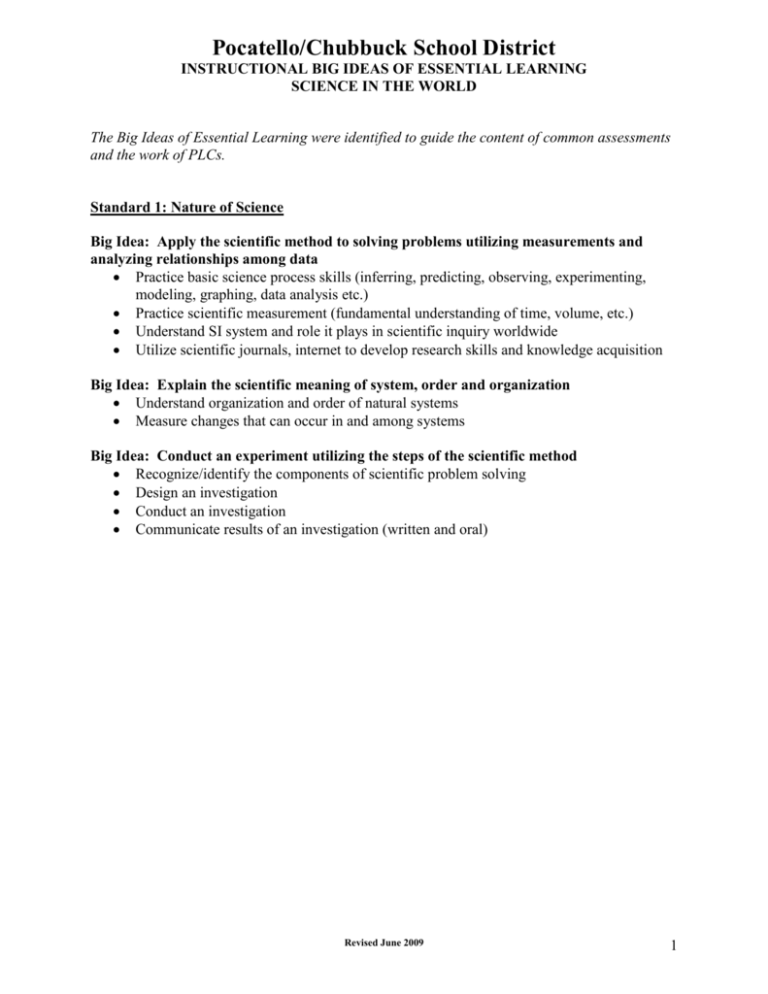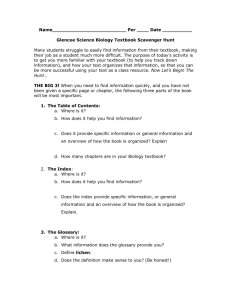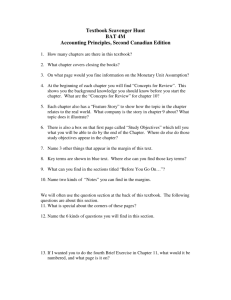Math Instructional Calendar
advertisement

Pocatello/Chubbuck School District INSTRUCTIONAL BIG IDEAS OF ESSENTIAL LEARNING SCIENCE IN THE WORLD The Big Ideas of Essential Learning were identified to guide the content of common assessments and the work of PLCs. Standard 1: Nature of Science Big Idea: Apply the scientific method to solving problems utilizing measurements and analyzing relationships among data Practice basic science process skills (inferring, predicting, observing, experimenting, modeling, graphing, data analysis etc.) Practice scientific measurement (fundamental understanding of time, volume, etc.) Understand SI system and role it plays in scientific inquiry worldwide Utilize scientific journals, internet to develop research skills and knowledge acquisition Big Idea: Explain the scientific meaning of system, order and organization Understand organization and order of natural systems Measure changes that can occur in and among systems Big Idea: Conduct an experiment utilizing the steps of the scientific method Recognize/identify the components of scientific problem solving Design an investigation Conduct an investigation Communicate results of an investigation (written and oral) Revised June 2009 1 Pocatello/Chubbuck School District Science in the World Instructional Calendar Textbook Resource: Multiple Textbooks/Resources STANDARD 1 Nature of Science Goal 1.1: Understand Systems, Order, and Organization CURRICULUM OBJECTIVES 9-10.B.1.1.1 Explain the scientific meaning of system, order, and organization. TASK ANALYSIS CL: E Content Limit: Students should be able to identify the components of a system and how the components interact to allow the system to function. Goal 1.2: Understand Concepts and Processes of Evidence, Models, and Explanations 9-10.B.1.2.1 Use observations and data as evidence on which to base scientific explanations. CL: E Content Limit: When presented observations. Students will be able to select the most reasonable explanation from a list of possibilities. 9-10.B.1.3.1 Measure changes that can occur in and among systems. CL: E Content Limit: Students should be able to explain changes that occur in systems. System, order, organization, form and function RESOURCES Goal 1.3: Understand Constancy, Change, and Measurement Explain the meaning of system, order, and organization Arrange the parts of a specific system and diagram how they interact (i.e. cellular system, circulatory system, ecosystem) ESSENTIAL VOCAB State that explanations are based on observations, evidence and testing Explain that a hypothesis must be testable Compare and contrast empirical data with measurable data Recognize that science changes with additional data Predict the most reasonable explanation for a set of observations and/or data Predict the most reasonable explanation for a set of observations and/or data Controlled experiment, dependent variable, independent variable, hypothesis, theory, law, scientific method, analyze, conclusion, modeling inferring, prediction, observation, qualitative data, quantitative data Test changes over time using the appropriate tool Convert between units within a metric system Metric system, SI conversion, temperature, distance, time, mass, volume, length, milli, centi, kilo, meter, deci, liter, gram, Celsius, degree, hecto, metric system CL = Content Limits – items in bold are assessed on the ISAT. Revised June 2009 Cognitive level codes: B – Memorize, C – Perform procedures, D – Demonstrate understanding, E – Conjecture, generalize, prove, F – Solve non-routine problems, make connections Prentice Hall Biology Textbook Glencoe Physical Science Textbook Biology PASS Textbook Earth/Space Science PASS Textbook Physical Science PASS Textbook SIOP Handbook Prentice Hall Biology Textbook Glencoe Physical Science Textbook Biology PASS Textbook Earth/Space Science PASS Textbook Physical Science PASS Textbook SIOP Handbook Prentice Hall Biology Textbook Glencoe Physical Science Textbook Biology PASS Textbook Earth/Space Science PASS Textbook Physical Science PASS Textbook SIOP Handbook 2 STANDARD 1 Nature of Science Goal 1.6: Understand Scientific Inquiry and Develop Critical Thinking Skills Goal 1.8: Understand Technical Communication CURRICULUM OBJECTIVES TASK ANALYSIS 9-10.B.1.6.1 Identify questions and concepts that guide scientific investigations. CL: E Content Limit: When presented a number of questions, students will be able to identify questions that can be investigated. 9-10.B.1.8.1 Analyze technical writing, graphs, charts, and diagrams. CL: E Content Limit: Students should be asked to derive information from graphs, charts, and diagrams. Describe the problem and/or question given an experiment Explain how observations guide scientific experiments List in order the steps of the scientific method Differentiate between scientific and non-scientific endeavors Interpret and draw conclusions from technical writing, graphs, charts and diagrams ESSENTIAL VOCAB Controlled experiment, dependent variable, independent variable, hypothesis, theory, law, scientific method, analyze, conclusion, modeling inferring, prediction, observation, graph data Graph, chart, diagram, spreadsheet, technical writing, interpret, data, axis, data table, legends, conclusion RESOURCES CL = Content Limits – items in bold are assessed on the ISAT. Revised June 2009 Cognitive level codes: B – Memorize, C – Perform procedures, D – Demonstrate understanding, E – Conjecture, generalize, prove, F – Solve non-routine problems, make connections Prentice Hall Biology Textbook Glencoe Physical Science Textbook Biology PASS Textbook Earth/Space Science PASS Textbook Physical Science PASS Textbook SIOP Handbook Prentice Hall Biology Textbook Glencoe Physical Science Textbook Biology PASS Textbook Earth/Space Science PASS Textbook Physical Science PASS Textbook SIOP Handbook 3





